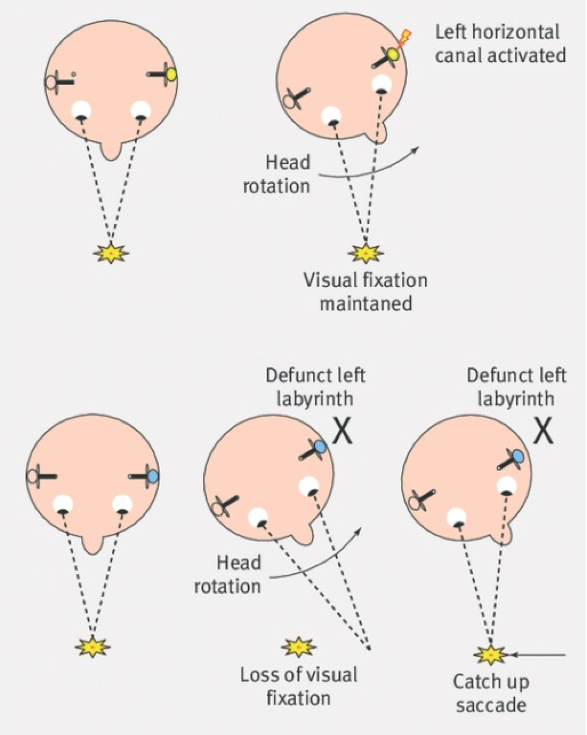Question
What is the Head Impulse Test, and what are the main advantages of vHIT (video Head Impulse Test) compared to cHIT (clinical Head Impulse Test)?
Answer
In 1988 Gabor M. Halmagyi and Ian S. Curthoys (Halmagyi, 1988) described for the first time the head impulse test in which the patient, placed in front of the examiner, is invited to stare at the tip of the examiner's nose while the head is guided in a series of limited amplitude but high-velocity movements which are unpredictable and without rebound. The goal of the test is to examine the canal's function at a high rotational velocity of the head.
In a healthy subject, the gaze remains steady on the visual target at the end of the rotation of the head because, as a result of a valid vestibular-oculomotor reflex (VOR), the eye will have performed a counter-rotation of equal amplitude (at high rotational velocity of the head, the visual information is absolutely irrelevant to the stabilization of the gaze due to the limitations of visual tracking and optokinetic reflex).
In a pathological subject, in which the VOR is impaired, at the end of the rotation of the head towards the affected side, since there has been no expected counter-rotation of the eyeball, there will be a fast movement of the eye. This is called the refixation saccade, with which the patient will recover the primitive line of gaze: the test will therefore be defined as positive.

Halmagyi’s clinical test is subject to certain limitations:
- The answer obtained is of the “all or nothing” type: it is not possible to evaluate intermediate degrees of deficit;
- In case of impaired VOR, the corrective saccadic that appears at the end of the movement of the head (OVERT saccades) is not the only compensatory response that the vestibuloculomotor system is able to provide: there are indeed saccadic movements invisible to the naked eye (COVERT saccades) that can be generated during the movement of the head and which, usually, contribute to the correct final position of the eye in the orbit. If the difference in position between the head and the line of gaze can be predicted early, refixation saccades, which may manifest during the movement of the head, can’t be identified without a dedicated instrumental device (high sampling rate cameras).
These are the reasons that have led to the development of specific devices for performing the test (vHIT, video Head Impulse Test devices).
The vHIT is the study of the vestibular-oculomotor reflex (VOR) through impulsive head movements performed at high velocity. Both eye and head movements are recorded.
The main parameters are:
- The gain, which derives from the ratio between the eye and head movement; its values are usually between 0 and 1, although in some conditions, it can be greater than the unit;
- The study of corrective saccades (latency, amplitude, velocity).
It should be noted that the parameters of normality may differ between canals, especially between horizontal and vertical ones.
Covert saccades can only be highlighted with the vHIT, while the overt saccades can be evaluated with the bedside tests and by the vHIT as well.
The importance of vHIT lies in its ease and quick execution, in not being annoying for the patient, in its feasibility in ambient light, in allowing for the first time the analysis of vertical canals, and in using a stimulus with physiological characteristics for the labyrinth.
In summary, the cHIT is positive only in case of very high functional deficits; however, it does not allow partial dysfunctions to be quantified (as it is either positive or negative) and is dependent on the experience and subjectivity of the examiner.
The vHIT quantifies the functional deficits in a continuum. It is an objective method that guarantees, through the study of saccade movements, verification of compensation strategies, with a significant impact on rehabilitation.
Resources for More Information
For more information, visit https://www.inventis.it/world

